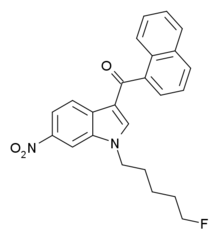AM-1235
 | |
| Legal status | |
|---|---|
| Legal status |
|
| Identifiers | |
| |
| CAS Number | |
| ChemSpider | |
| UNII | |
| CompTox Dashboard (EPA) | |
| Chemical and physical data | |
| Formula | C24H21FN2O3 |
| Molar mass | 404.433 g/mol g·mol−1 |
| 3D model (JSmol) | |
| |
| |
| | |
AM-1235 (1-(5-fluoropentyl)-3-(naphthalen-1-oyl)-6-nitroindole) is a drug that acts as a potent and reasonably selective agonist for the cannabinoid receptor CB1.
Pharmacology
Pharmacodynamics
AM-1235 is a cannabinoid receptor agonist with Ki of 1.5nM at CB1 compared to 20.4nM at CB2.[1] While the 6-nitro substitution on the indole ring reduces affinity for both CB1 and CB2 relative to the unsubstituted parent compound AM-2201, CB2 affinity is reduced much more, resulting in a CB1 selectivity of around 13x.[2] This is in contrast to other related compounds such as AM-1221 where a 6-nitro substitution instead confers significant selectivity for CB2.[3]
Pharmacokinetics
This section needs additional citations for verification. (July 2012) |
AM-1235 metabolism differs only slightly from that of JWH-018. AM-1235 N-dealkylation produces fluoropentane instead of pentane (or plain alkanes in general). It has been speculated that the fluoropentane might function as an alkylating agent or is further metabolized into toxic fluoroacetic acid. This is not true since fluoroalkanes do not act as alkylating agents under normal conditions and uneven fluoroalkane chains metabolize into substantially less toxic fluoropropanoic acid.[4][5]
See also
- AM-694
- AM-906
- AM-1235
- AM-2232
- AM-2233
- AM-2389
- JWH-018
- List of AM cannabinoids
- List of JWH cannabinoids
- O-1812
- THJ-2201
References
- ^ US patent 7241799, Makriyannis A, Deng H, "Cannabimimetic indole derivatives", granted 2007-07-10
- ^ Deng, Hongfeng (2000). Design and synthesis of selective cannabinoid receptor ligands: Aminoalkylindole and other heterocyclic analogs (PhD. Dissertation). University of Connecticut.
- ^ WO patent 200128557, Makriyannis A, Deng H, "Cannabimimetic indole derivatives", granted 2001-06-07
- ^ Millington JE, Pattison FLM. TOXIC FLUORINE COMPOUNDS: XII. ESTERS OF ω-FLUOROALCOHOLS. Canadian Journal of Chemistry. 1956 Nov;34(11):1532-1541.[permanent dead link]
- ^ Pattison FLM, Howell WC, Woolford RG. TOXIC FLUORINE COMPOUNDS: XIII. ω-FLUOROALKYL ETHERS. Canadian Journal of Chemistry. 1957 Feb;35(2):141-148.[permanent dead link]
